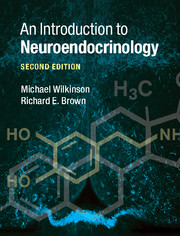Book contents
- Frontmatter
- Dedication
- Contents
- Preface to the second edition
- Acknowledgements
- List of abbreviations
- 1 Classification of chemical messengers
- 2 The endocrine glands and their hormones
- 3 The pituitary gland and its hormones
- 4 The hypothalamic hormones
- 5 Neurotransmitters
- 6 Neurotransmitter and neuropeptide control of hypothalamic, pituitary and other hormones
- 7 Regulation of hormone synthesis, storage, release, transport and deactivation
- 8 Regulation of hormone levels in the bloodstream
- 9 Steroid and thyroid hormone receptors
- 10 Receptors for peptide hormones, neuropeptides and neurotransmitters
- 11 Neuropeptides I: classification, synthesis and co-localization with classical neurotransmitters
- 12 Neuropeptides II: function
- 13 Cytokines and the interaction between the neuroendocrine and immune systems
- 14 Methods for the study of behavioral neuroendocrinology
- 15 An overview of behavioral neuroendocrinology: present, past and future
- Index
- References
11 - Neuropeptides I: classification, synthesis and co-localization with classical neurotransmitters
Published online by Cambridge University Press: 05 June 2015
- Frontmatter
- Dedication
- Contents
- Preface to the second edition
- Acknowledgements
- List of abbreviations
- 1 Classification of chemical messengers
- 2 The endocrine glands and their hormones
- 3 The pituitary gland and its hormones
- 4 The hypothalamic hormones
- 5 Neurotransmitters
- 6 Neurotransmitter and neuropeptide control of hypothalamic, pituitary and other hormones
- 7 Regulation of hormone synthesis, storage, release, transport and deactivation
- 8 Regulation of hormone levels in the bloodstream
- 9 Steroid and thyroid hormone receptors
- 10 Receptors for peptide hormones, neuropeptides and neurotransmitters
- 11 Neuropeptides I: classification, synthesis and co-localization with classical neurotransmitters
- 12 Neuropeptides II: function
- 13 Cytokines and the interaction between the neuroendocrine and immune systems
- 14 Methods for the study of behavioral neuroendocrinology
- 15 An overview of behavioral neuroendocrinology: present, past and future
- Index
- References
Summary
Many chemical messengers regulate neural activity, including neurotransmitters (Chapter 5), steroid hormones (Chapter 9) and peptide hormones (Chapter 10). This chapter, and Chapter 12, examines how the class of chemical messengers termed neuropeptides regulates neural activity. The topic of neuropeptides is now an extensive one and we divide the coverage into two parts. This chapter will describe the classification and synthesis of neuropeptides and their co-localization with classical neurotransmitters. Chapter 12 examines the functions of neuropeptides in the brain and neuroendocrine system.
Classification of neuropeptides
The realization that neuropeptides can act as neurotransmitters took place after the discovery of most of the “classical,” or small molecule, neurotransmitters, such as NE, glutamate and ACh. Perhaps the simplest and obvious difference between these two classes of neurotransmitter is the size of the molecules; neuropeptides range in size from 2 to at least 40 amino acids, whereas a molecule such as NE is derived from a single amino acid (tyrosine) (see Table 7.1). Another difference is that neuropeptides are more versatile in their range of biological activities. For example, some peptide hormones are synthesized in endocrine glands, in fat cells and in the GI tract, but are also produced in the brain, where they act as neurotransmitters or neuromodulators. Another significant distinguishing characteristic of neuropeptides is their mode of synthesis. Classical neurotransmitters such as amino acids or catecholamines are formed by two or three enzymatic steps, often in the nerve terminal. Neuropeptides, on the other hand, are synthesized from large prepropeptides in the neuronal cell body (e.g. see section 7.2.1; Figure 7.2).
In terms of nomenclature, peptide hormones were traditionally and sensibly named after the first function they were known to serve. Thus, the pituitary hormones (ACTH, TSH, FSH, GH, etc.) were named for their actions at their target cells; for example, TSH stimulates the thyroid gland. Hypothalamic-releasing hormones (CRH, TRH, GnRH, GHRH, etc.) were named for their functions at pituitary target cells; and the hormones of the gastrointestinal (GI) tract (CCK, VIP, gastrin, etc.) were named based on their gastrointestinal functions.
- Type
- Chapter
- Information
- An Introduction to Neuroendocrinology , pp. 257 - 285Publisher: Cambridge University PressPrint publication year: 2015



